A guide to purchasing Patient Transport Stretchers for your hospital in 2025
With so many options for Patient Stretchers on the market, you may find it challenging to select the best patient stretcher that meets the needs of your hospital environment.
In this article, we cover what to look for when buying patient stretchers for your hospital, and in particular, for patient transport. We’ll go over the key factors to look out for, what you should avoid, and compare some of the most common patient transport stretchers, in view of making your decision easier and quicker.
But first, let’s define what a patient stretcher is and explore some characteristics specific to patient transport stretchers.
What is a patient stretcher?
Patient stretchers are primarily designed for short-term use by a patient, either to transfer a patient from one area of the hospital to another, or for a surgical procedure. The patient stretchers on the market vary from very basic, transport-only stretchers, to very specific and specialist stretchers for complex surgical procedures.
The best patient transport stretchers will have the following characteristics:
Versatile height range
A versatile height range is key for enabling patients to mobilise safely and allowing staff to operate the stretcher at an optimal position. Some patient stretchers have very low minimum heights, which is excellent for promoting easier mobilisation and reducing the risk of fall-related injury, however, it’s important to also consider the maximum height of a stretcher and whether it caters to the staff that will frequently be using the stretcher.
Lightweight but robust construction
Patient transport stretchers are used almost constantly for transporting patients around a hospital, and as such, they need to be lightweight and manouvreable. Along with being lightweight, however, the best patient stretchers will be robustly built to withstand the demands of the busy hospital environment.
Fifth-wheel mobility
The best patient stretchers will have a fifth wheel, typically activated at the head or foot end of the stretcher. The fifth wheel acts as a directional wheel, making the stretcher much easier to manoeuvre, particularly around corners and in crowded environments.
An option for powered drive control
A lot of the best patient stretchers will have the option to add powered drive control. Essentially, this adds a motorised wheel to the stretcher to take the pushing force off your staff. Powered drive control is particularly useful for patient transport stretchers, which are typically pushed over long distances every day.
Pressure-relieving features
Despite the target of 95% of ED patients being seen, treated, or discharged within 4 hours, with pressure increasing in hospitals and emergency departments trolley stays of longer than 4 hours are becoming increasingly common. Because of this, it’s important to consider patient stretchers with features such as auto-regression, which promotes patient comfort and pressure relief.
What factors should you consider when choosing a patient stretcher?
We recommend that you start by identifying the needs of your emergency department team and environment, and any other areas of the hospital where the stretcher will be frequently used. Like any other hospital product, there are better patient stretchers than others, but in the main, the best stretcher for you will depend mostly on your specific requirements.
Some important questions to consider before choosing a patient stretcher:
- How long will patients typically stay on the stretcher?
- What distance will the stretcher be travelling on average per day?
- Will the stretcher be used for surgery as well as transport?
- If used for surgery, what procedures will be performed?
- Will the stretcher require imaging compatibility?
- What materials are used to manufacture the patient stretcher?
- What ergonomic benefits will the patient stretcher provide for staff?
Understanding how long patients are likely to be staying on the stretcher will help you in deciding whether to choose a patient stretcher that emphasises pressure relief and comfort and knowing the distance the stretcher is likely to travel each day will help in prioritising whether a lighter stretcher is most suitable for your staff. Whether or not the stretcher will also be used for surgery is a key consideration, as some stretchers are designed primarily for patient transport and would not be ideal for surgical procedures. Knowing whether the procedures will require imaging can help you select patient stretchers that allow for imaging applications such as X-ray. Lastly, consider the ergonomic benefits — whether the patient stretcher is comfortable and safe for your staff to use over long periods.
By considering and answering these questions, you’ll have a much greater understanding of your requirements, making the decision-making process quicker.
Who are the main manufacturers of patient stretchers?
Some of the main manufacturers & distributors of patient stretchers in the UK include:
- Stryker
- Linet
- Arjo
- Acime
- Hillrom
- Anetic Aid
- Howard Wright
- Felgains
Comparing the best stretchers for patient transport
Some of the best stretchers for patient transport and emergency department use include:
- Stryker Prime
- Linet Sprint 200
- Arjo Lifeguard 50
- Acime Skot Power
- Hillrom Transport
- Anetic Aid QA3
- Howard Wright M9 Transfer
- Felgains MultiFlow
- Felgains PatientFlow
Let’s dive in and look at each stretcher in detail, looking at their positives and weaknesses, and how they stack up against each other.
Stryker Prime
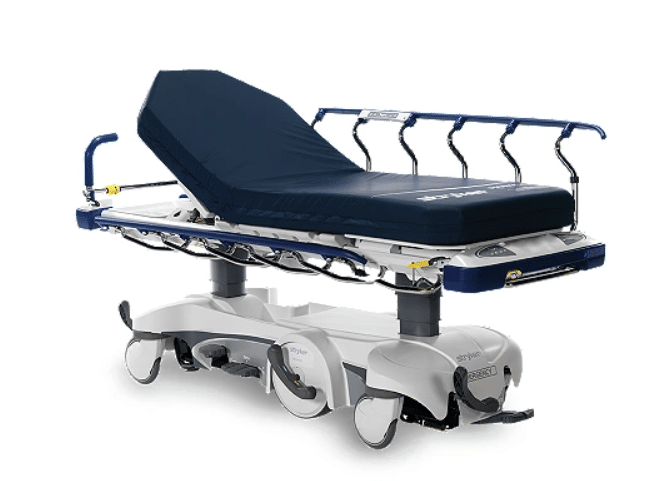
Stryker’s Prime Series Stretchers are designed to help reduce physical strain on clinicians, enhance patient comfort and help drive hospital efficiency. Transporting heavier patients
is made easier with Stryker’s advanced mobility; while electric functionality gives patients the independence to adjust themselves without calling for caregiver assistance.
Key features & benefits
- Advanced mobility options – Stryker’s Prime offers three advanced mobility options – the ‘Zoom Motorised Drive System’ that virtually eliminates manual push force; the ‘Big Wheel’ that reduces push force and steering effort; and the retractable Fifth Wheel that helps make cornering easier.
- Electric-powered lift – eliminates manual pumping, allowing for quick patient access and caregiver safety.
- 5th wheel – The 5th wheel under the centre of the trolley means that the stretcher is very manoeuvrable – especially important in crowded emergency departments.
- Option for electric or hydraulic backrest
- Power-washable design
- Central braking with dual-end activators
- Safe working load – 318kg
Drawbacks
- Limited low-height capacity – The Prime has a minimum platform height of 52.7cm, which some patients may find too high for easily mobilising on and off the stretcher.
- Width – The Prime stretcher has quite a wide overall width of 76cm, which may be prohibitive in crowded environments.
- No auto-regression feature – The Prime lacks single or dual auto-regression, which could lead to patients experiencing increased discomfort and risk of pressure injury over long periods on the stretcher.
Linet Sprint 200
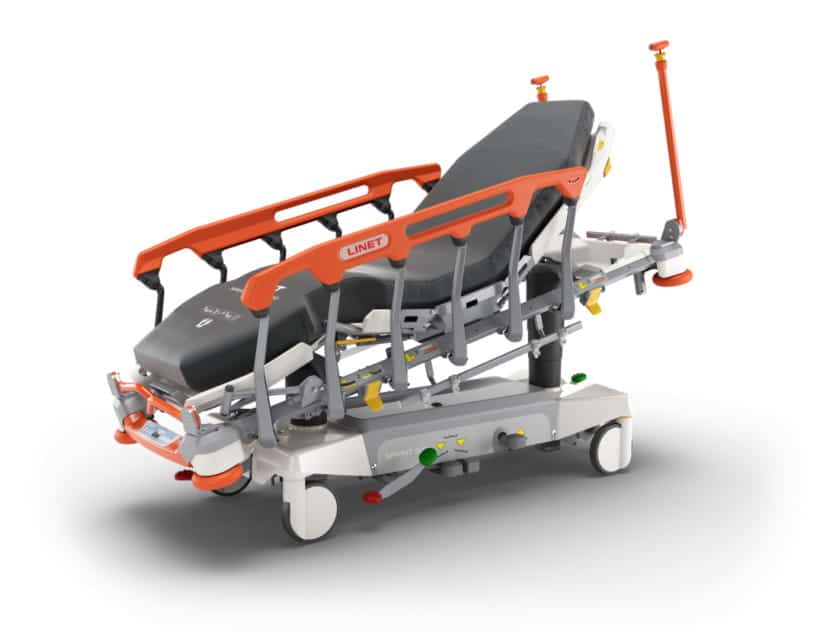
The Linet Sprint 200 is a premium hydraulic emergency transport stretcher, complete with powered drive assist.
Key features & benefits
- Powered drive control – reduces the pushing forces to the touch of a button, reducing the risk of strain injury to staff and increasing the comfort for the patient.
- IV&Drive – combines push handles and IV poles into one, to improve pushing ergonomics and reduce the need for removable IV poles that could likely get missing or damaged.
- Hydraulic foot controls – reliable and low-maintenance for rigorous use all day, every day.
- 5th wheel – The 5th wheel under the centre of the trolley means that the stretcher is very manoeuvrable – especially important in crowded emergency departments.
- Central braking, accessed from all four sides
- Angle indicators to help with positioning
- Folding bed-exit handle
- Built-in scales
- Safe working load – 320kg
Drawbacks
- Lack of X-ray tunnel – Surprisingly, the Linet range of trolleys have no X-Ray tunnel at all. Chest X-Rays are achievable but if you want to do full-length imaging for trauma patients, sadly you can’t. This may result in additional unnecessary transfers for very sick patients.
- Limited low-height capacity – The Sprint 200 has a minimum platform height of 53cm, which some patients may find too high for easily mobilising on and off the stretcher.
- Hydraulic controls – whilst a benefit on the reliability front, hydraulic controls offer a less comfortable experience for the patient when compared to electric controls, particularly on the lift function, which can feel jerky and uncomfortable as a patient.
- Multiple features and electric components – Whilst the number of features on the Sprint 200 is undeniably impressive, I think it’s fair to say that with every additional feature, the risk of something breaking or failing understandably increases, and this is particularly true with electric functions. Powerdrives are excellent but are also performing a particularly arduous job – some will find that simple is best. This is something to bear in mind when considering the environment in which you’ll be using your stretchers.
- Heavy – The Linet Sprint 200 is the heaviest of the stretchers in this article, weighing 167kg. This could result in staff experiencing fatigue when pushing the stretcher for long periods. While the powerdrive system is designed to completely remove this risk, the weight of the trolley is still noticeable when manoeuvring through a hospital.
Arjo Lifeguard 50
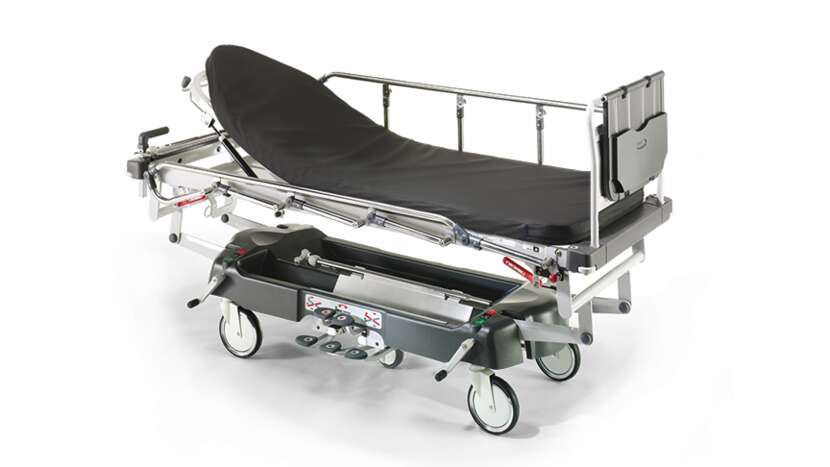
The Lifeguard 50 from Arjo is a high-specification trolley that has been designed to cope with the rigours and demands of an emergency department.
Key features & benefits
- High maximum height – The Lifeguard 50 has a very high maximum height of 93cm, providing an ergonomic working range for clinicians and caregivers to interact with patients.
- 5th wheel – The 5th wheel under the centre of the trolley means that the stretcher is very manoeuvrable – especially important in crowded emergency departments.
- Imaging compatibility – Full-length radio-translucent mattress platform and options for x-ray platforms and compatibility with C-arm cameras.
- Dual-side hydraulic foot controls for height and tilt adjustment
Drawbacks
- Low safe working load – Along with the Howard Wright M9, the Lifeguard’s 250kg safe working load is the lowest of the stretchers in this article, which could lead to some of your patients not being able to use the stretcher.
- No option for electric control – While hydraulic controls are known to be reliable, they offer a less comfortable experience for the patient when compared to electric controls, particularly on the lift function, which can feel jerky and uncomfortable as a patient.
- No auto-regression feature – The Lifeguard 50 lacks single or dual auto-regression, which could lead to patients experiencing increased discomfort and risk of pressure injury over long periods on the stretcher.
Acime Skot Power
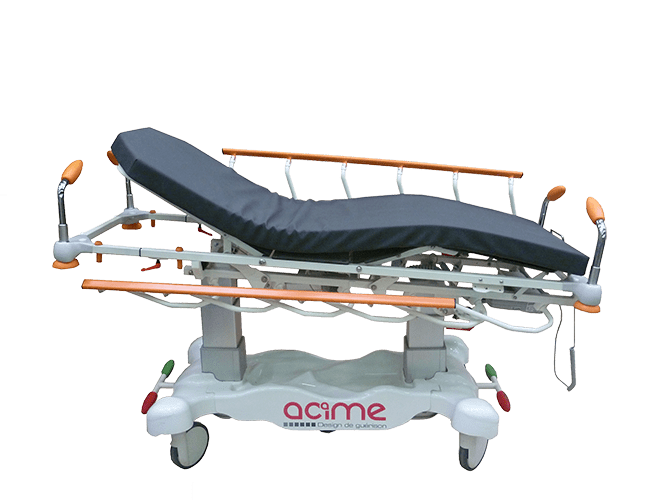
The Acime Skot Power is an electrically-operated emergency and transfer stretcher, designed for reliable and smooth patient transport.
Key features & benefits
- High maximum height – The Skot Power has a very high maximum height of 92cm, providing an ergonomic working range for clinicians and caregivers to interact with patients.
- 5th wheel – The 5th wheel under the centre of the trolley means that the stretcher is very manoeuvrable – especially important in crowded emergency departments.
- Easily removable casing for rapid cleaning
- Centralised braking
Drawbacks
- Limited low height capacity – The Skot Power has a minimum platform height of 60cm, which is the highest out of all the stretchers on this list, which some patients may find too high for easily mobilising on and off the stretcher.
- No auto-regression feature – The Skot Power lacks single or dual auto-regression, which could lead to patients experiencing increased discomfort and risk of pressure injury over long periods on the stretcher.
Hillrom Transport
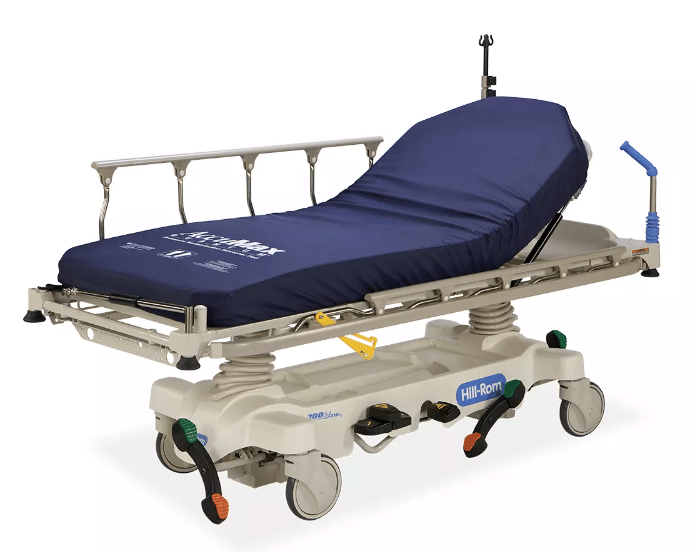
The Hillrom Transfer is a heavy-duty stretcher built to provide reliable patient transport.
Key features & benefits
- High safe working load – The Hillrom Transfer has a high safe working load of 318kg, meaning you can use it with most of your patients.
- 5th wheel – The 5th wheel under the centre of the trolley means that the stretcher is easily manoeuvrable – especially important in crowded hospital environments.
- Simple-to-activate braking and steering pedal
- Power washable and easy-to-clean deck and side rail design
Drawbacks
- Limited low-height capacity – The Hillrom Transfer has a minimum platform height of 52cm, which some patients may find too high for easily mobilising on and off the stretcher.
- No auto-regression feature – The Hillrom Transfer lacks single or dual auto-regression, which could lead to patients experiencing increased discomfort and risk of pressure injury over long periods on the stretcher.
Anetic Aid QA3
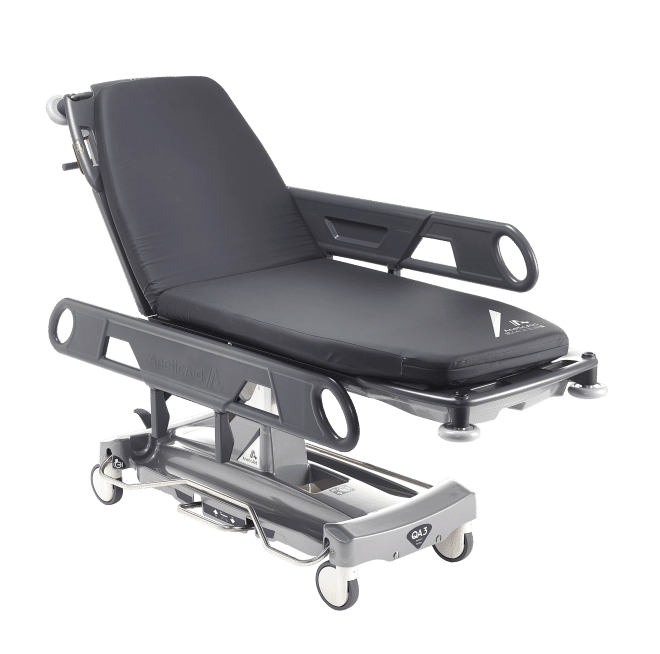
The Anetic Aid QA3 is compact, lightweight and manoeuvrable, ideal for patient transport to and from theatres and wards.
Key features & benefits
- Optional powered drive assist – The QA3 DRIVE model features powered drive assist, reducing the pushing forces on the staff and subsequently reducing the risk of injury.
- 5th wheel – The 5th wheel under the centre of the trolley means that the stretcher is very manoeuvrable – especially important in crowded hospital environments.
- Option for electrically or hydraulically operated controls
- Central braking, activated from both sides
Drawbacks
- Lower maximum height compared to other stretchers – The 77cm maximum height could lead to taller staff finding it more difficult to attend to patients while maintaining good posture and ergonomics.
- Single-column lift – The single-column design may hinder c-arm camera access, should the stretcher be used for imaging procedures.
- No auto-regression feature – The QA3 lacks single or dual auto-regression, which could lead to patients experiencing increased discomfort and risk of pressure injury over long periods on the stretcher.
Howard Wright M9 Transfer
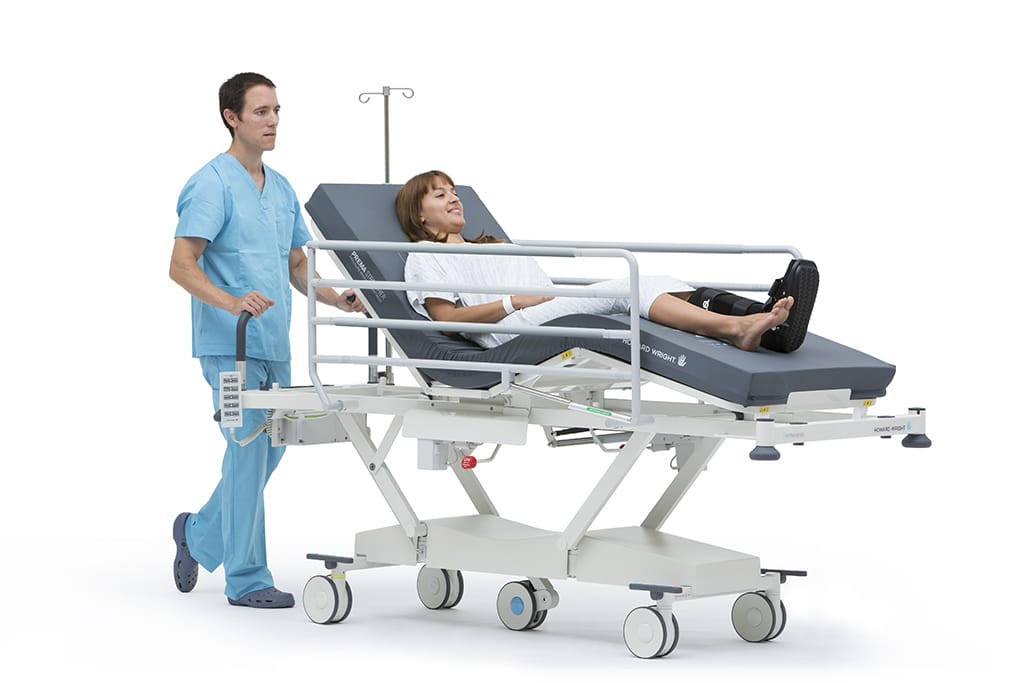
The Howard Wright M9 is a fully electric patient stretcher with a low minimum height to increase patient safety and comfort.
Key features & benefits
- Low mattress platform height – The Howard Wright M9 has a minimum height of just 350mm, enabling easier mobilisation and reducing the risk of injury from falls.
- Good maximum platform height – As well as having a very low minimum height, the M9 has a respectable maximum platform height of 80cm, providing an ergonomic working range for clinicians and caregivers to interact with patients.
- Fully electric with battery backup – to reduce manual handling and provide a comfortable experience for patients.
- 5th wheel – The 5th wheel under the centre of the trolley means that the stretcher is very manoeuvrable – especially important in crowded emergency departments.
Drawbacks
- Low safe working load – Along with the Arjo Lifeguard 50, the M9’s 250kg safe working load is the lowest of the stretchers in this article, which could lead to some of your patients not being able to use the stretcher.
- No auto-regression feature – The M9 lacks single or dual auto-regression, which could lead to patients experiencing increased discomfort and risk of pressure injury over long periods on the stretcher.
Felgains MultiFlow
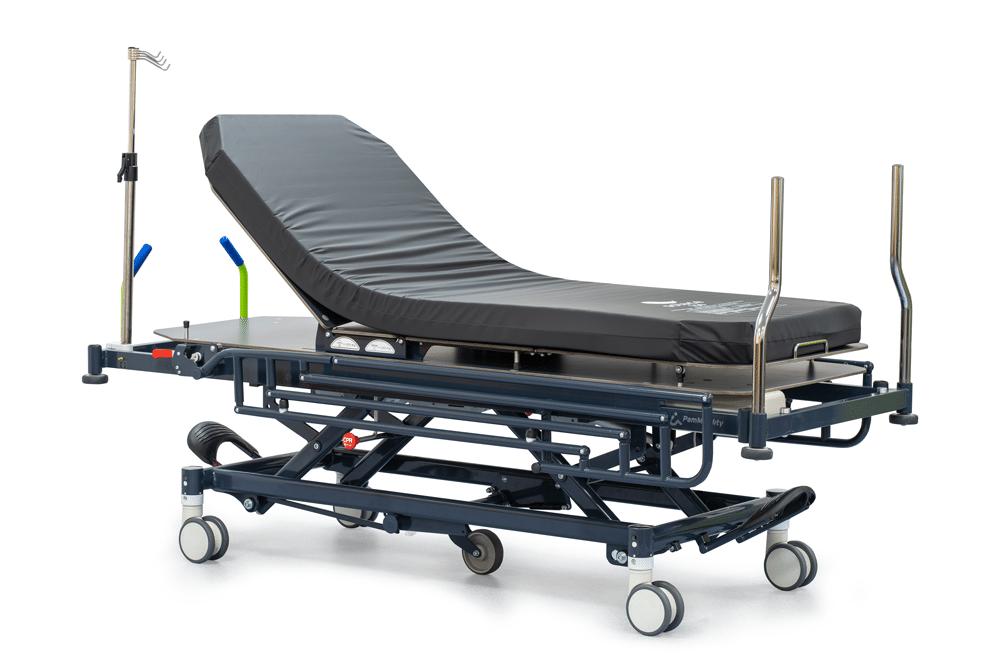
The Felgains MultiFlow stretcher combines an industry-leading low height of 420mm with full x-ray compatibility to enable easier mobilisation and bring a new level of patient safety to your emergency department.
Key features & benefits:
- Ultra-low mattress platform height – The industry-leading low height of 430mm reduces the risk of falls and fall-related injury in your emergency department and also promotes easier mobilisation and discharge, increasing patient flow through your hospital.
- Fully X-ray compatible – Radiolucent mattress platform and a full-length X-ray tunnel for unrestricted imaging.
- 60601-2-52 compliant – The MultiFlow’s side rails are fully compliant with the ISO 60601-2-52 standard, helping your Trust meet the most recent health and safety guidelines.
- 5th wheel – The 5th wheel under the centre of the trolley means that the MultiFlow is very manoeuvrable – especially important in crowded emergency departments.
- Robust and flexible – The MultiFlow has heavy-duty IV poles that double up as push handles, giving you options for excellent ergonomics when pushing the trolley.
Drawbacks
- Lower safe working load compared to other stretchers – The 270kg safe working load means the MultiFlow isn’t suitable for use with bariatric patients.
Felgains PatientFlow
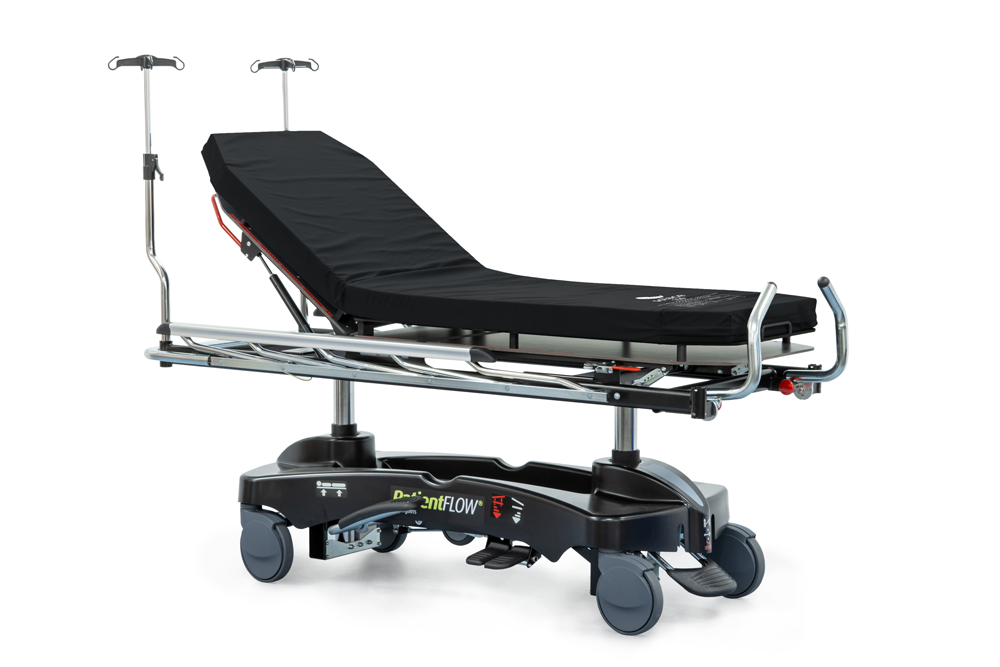
The PatientFlow from Felgains is a lightweight yet robust patient stretcher designed for transporting patients all day, every day.
Key features & benefits
- Lightweight but robust construction – The PatientFlow is the most lightweight of all the patient stretchers in this article, which can make a big difference when the stretcher has to be used all day, every day, in busy hospital environments.
- 5th wheel – The 5th wheel under the centre of the trolley means that the PatientFlow is very manoeuvrable – especially important in crowded emergency departments.
- High safe working load – The PatientFlow has a high safe working load of 320kg, meaning you can use it with most of your patients.
- Robust and flexible – the PatientFlow has heavy-duty IV poles that double up as push handles, giving you options on pushing positions for excellent ergonomics
- Available in both hydraulic and electric hybrid electric versions; the Electric version allows for smooth movements across all functions, whilst the Hybrid Electric version of the PatientFlow has powered functionality and the non-essential functions are gas-spring assisted – maximising battery capacity.
Drawbacks
- Limited low-height capacity – The PatientFlow has a minimum platform height of 55cm, which some patients may find too high for easily mobilising on and off the stretcher.
- No auto-regression feature – The PatientFlow lacks single or dual auto-regression, which could lead to patients experiencing increased discomfort and risk of pressure injury over long periods on the stretcher.
Patient stretcher comparison table
| Stryker Prime | Linet Sprint 200 | Arjo LifeGuard 50 | Acime Skot Power | Hillrom Transport | AneticAid QA3 | Howard Wright M9 | Felgains MultiFlow | Felgains PatientFlow | |
| Safe Working Load | 318kg | 320kg | 250kg | 300kg | 318kg | 320kg | 250kg | 270kg | 320kg |
| Max Patient Weight | 306kg | 280kg | Unknown | Unknown | 227kg | 320kg | 220kg | 230kg | 260kg |
| Lowest Height (cm) | 52.7 | 53 | 56 | 60 | 52 | 47.5 | 35 | 42 | 55 |
| Highest Height (cm) | 86.4 | 86 | 93 | 92 | 87 | 77.5 | 80 | 82 | 85 |
| Platform Size (cm) | 76 x 191 | 76 x 203 | 67 x 195 | 62 x 190 | 66 x 190 | 80 x 215 | 70 x 200 | 70 x 200 | 70 x 195 |
| Weight of stretcher | Unknown | 167kg | Unknown | Unknown | 120kg | 128kg | 130kg | Unknown | 102kg |
| Hydraulic Option | Yes | Yes | Yes | Yes | Yes | Yes | No | No | Yes |
| Electric Option | Yes | No | No | Yes | Yes | Yes | Yes | Yes | Yes |
| Auto Chair Position | Yes | No | No | No | Unknown | No | Yes | Yes | No |
| Trendelenburg | Yes | Yes | Yes | Yes | Yes | Yes | Yes | Yes | Yes |
| Standard Warranty Package | 2 years | 2 years | 1 year | 2 years | Unknown | 1 year | 2 years | 2 years | 2 Year |
| Power Drive Option | Yes | Yes | No | No | No | Yes | Yes | No | Yes |
| Single/Double Column | Double | Double | Double | Double | Double | Single | Double | Double | Double |
| Fifth Wheel | Yes | Yes | Yes | Yes | Yes | Yes | Yes | Yes | Yes |
| Expected Service Life | Unknown | Unknown | 10 years | Unknown | 10 years | 10 years | 7 years | 10 years | 10 years |
| X-Ray Tunnel available | Yes (Prime X) | No | No | No | No | Yes | Yes | Yes | Yes |
Which stretcher should you choose for your Trust?
Which patient stretcher you choose will depend on your specific needs and requirements, so it’s difficult for us to say which stretcher you should choose, but we trust this article has given you a clear picture of the stretchers that are available on the market, and their positives and drawbacks, to make your decision easier.
We can offer trials and demonstrations of the two Felgains stretchers; the PatientFlow and MultiFlow, so if this is something that you would find beneficial please get in touch, either by calling the team on 01473 741144, or by filling in the form below.
Related articles
A complete comparison of the most popular Day Surgery Trolleys of 2023 | Reviews & Comparisons
Felgains MultiFlow Low Stretcher vs Anetic Aid QA3 Stretcher; How do they compare?
How do low-height patient stretchers reduce the risk of inpatient falls?
Get in touch
Got a question or want to send us a message? Let’s talk.
